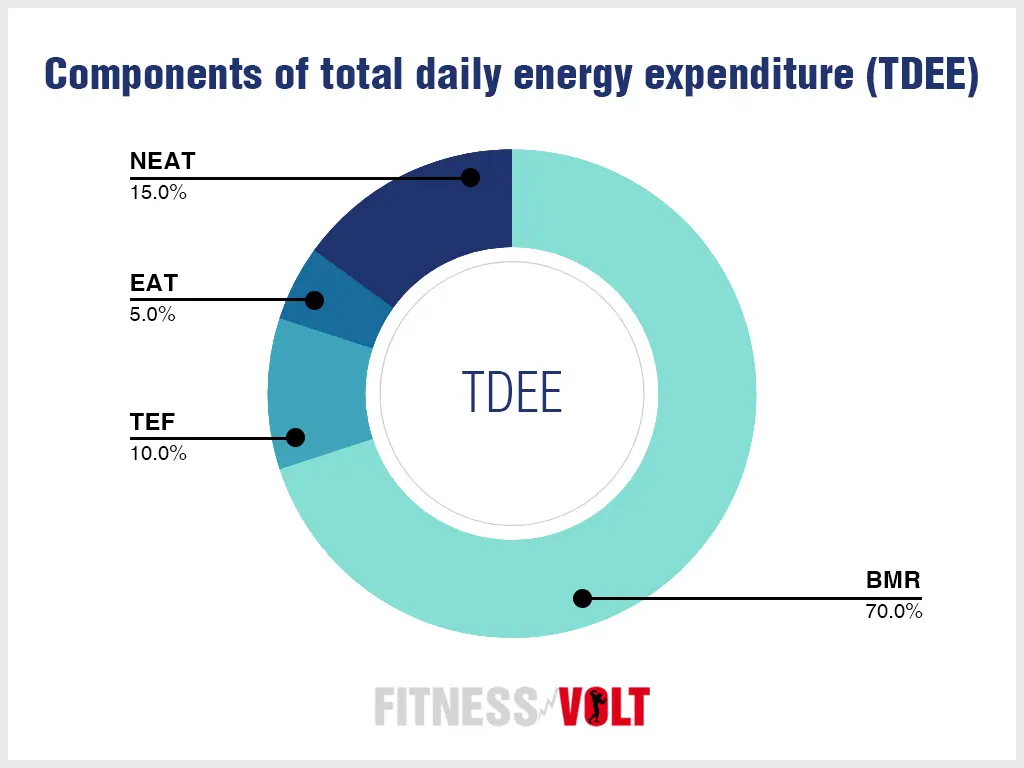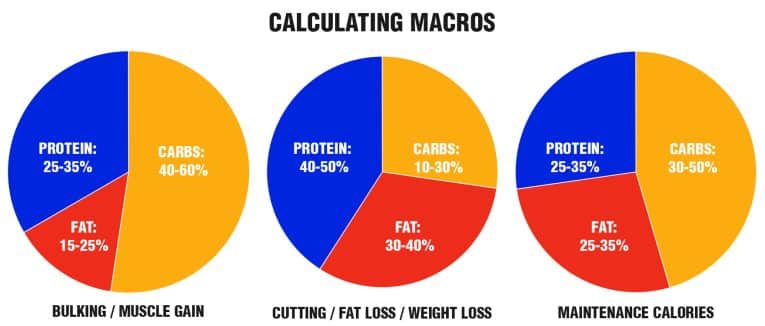Find your ideal caloric intake with our accurate TDEE Calculator and learn the number of calories you burn each day. Developed by nutritionists and fitness experts, this calculator also provides your BMI, IBW, BMR, macro-nutrient profile, and numerous other significant health metrics.
My TDEE Stats:
Download your PDF Report
Please enter your full name
Your Maintenance Calories
calories per day
calories per week
| Basal Metabolic Rate | calculated calories per day |
| Sedentary | calculated calories per day |
| Light Exercise | calculated calories per day |
| Moderate Exercise | calculated calories per day |
| Heavy Exercise | calculated calories per day |
| Athlete | calculated calories per day |
Ideal Weight: calculated
| G.J. Hamwi Formula (1964) | calculated |
| B.J. Devine Formula (1974) | calculated |
| J.D. Robinson Formula (1983) | calculated |
| D.R. Miller Formula (1983) | calculated |
BMI Score: calculated
| 18.5 or less | Underweight |
| 18.5 – 24.99 | Normal Weight |
| 25 – 29.99 | Overweight |
| 30+ | Obese |
Maximum Muscular Potential
Macronutrients
protein
fats
carbs
protein
fats
carbs
protein
fats
carbs
protein
fats
carbs
protein
fats
carbs
protein
fats
carbs
protein
fats
carbs
protein
fats
carbs
protein
fats
carbs
Whether you’re aiming to shed pounds, build muscle, or maintain your current physique, our TDEE Calculator (version 4.7.5) is your go-to tool. It goes beyond calculating your daily energy needs, providing insights into BMI, BMR, and ideal weight. With personalized calorie and macronutrient recommendations tailored to your aspirations, our calculator is comprehensive and uses scientifically validated formulas to ensure accurate results. Plus, you can generate a PDF report of your data for convenient tracking.
We regularly update our calculator to reflect the latest research in nutrition and metabolism. It’s designed to be user-friendly across all devices, allowing you to adjust inputs and see real-time changes in results. Rest assured, your information is never stored or shared.
Enhance your fitness journey further with our related tools. Check out our BMI Calculator to understand your body mass index, our Macro Calculator for detailed macronutrient planning, and our Calorie Deficit and Weight Loss Calculator to optimize your diet strategy. Together, these resources offer a full spectrum of insights, complementing your TDEE results for a well-rounded health and fitness approach.
While our calculator provides valuable insights, it’s always best to consult with a healthcare professional for personalized advice. Our goal is to provide you with accurate, helpful information to support your health and fitness journey.
How to Use Our TDEE Calculator
It’s quite simple actually! Here are step-by-step instructions for using the calculator.
- Choose your unit of measurement in either imperial (lbs and inches) or metric (kg and cm).
- Select your gender.
- Enter your age, weight, and height.
- Pick your activity level:
- Sedentary (office job)
- Light Exercise (1-2 days/week)
- Moderate Exercise (3-5 days/week)
- Heavy Exercise (6-7 days/week)
- Athlete (2x per day)
- Type in your body fat percentage (optional but can give more accurate results).
- Calculate TDEE
Voila! The calculator will then provide your TDEE estimate results.
Watch how to use our calculator:
How To Read My TDEE?
After you punch in the basic info (age, height, weight, daily activity level, and body fat %) required; you’ll see a few different approximate values. Now, these results are pretty simple to understand and we’ve provided a brief definition of each.
Maintenance calories calculated – The calculator provides the same results as a maintenance calorie calculator and this value is the number of calories you need to consume to maintain your current body weight.
Calories per week – This is the total number of calories you’ll eat in one week based on your fitness goals.
Ideal weight – This value is simply a recommendation for a healthy weight but the more muscle you have, the less you need to really worry about this part.
Body mass index (BMI) score – BMI score is based on your height and weight. Now, the ranges aren’t always 100% accurate, so if you happen to be within these numbers, consider your body fat level to gauge whether or not you have a healthy BMI [1].
- 18.5 or less (Underweight)
- 18.5 – 24.9 (Normal weight)
- 25 – 29.9 (Overweight)
- 30 – 40 (Obese)
- 40+ (Extremely obese)
Tip: Also try our BMI and reverse BMI calculator.
Macronutrients – Macronutrients are needed in large amounts so this is a big focus for meeting your recommended daily caloric requirements [2].
Now, macros aren’t typically included in a standard TDEE calculator since most tend to act only as a calories burned tool.
But, our TDEE formula includes both training day and rest day macros. So, you can know exactly how much protein, carbs, and fats to consume every day to reach your goals. And these numbers vary based on all of the required necessary information including weight, and activity level.
- Protein is the building block of muscle tissue and the TDEE formula factors it into your diet based on your needs [3].
- But, carbs are an essential energy source that can break down fast enough to support your high-intensity exercise. And carbs are proven to support anabolism which is necessary for muscle growth [4].
- Fats are also very important for brain function, testosterone production, and metabolism regulation. So, all macros are taken into account for optimal health based on all factors that you enter in the calculator [5].
What is TDEE?
TDEE stands for total daily energy expenditure and this value is found by calculating how many total calories you burn on a daily basis from normal bodily functions and physical activity. A calorie or kilocalorie is the amount of heat needed to raise the temperature of one kilogram of water by 1 degree Celsius [6].
It’s like your body’s daily energy budget. Understanding your TDEE is crucial for achieving your fitness goals. Your TDEE can change as you gain muscle, lose weight, or become more active. It’s a guide for your nutrition that should be regularly revisited. Depending on your fitness goals, you may aim to eat less than your TDEE to lose weight, more than your TDEE to gain muscle, or adjust your macronutrient ratios to maintain your weight while changing your body composition. Here is a detailed article on TDEE.
How TDEE is Calculated
There are several equations for calculating TDEE but the Mifflin-St Jeor equation is known to be the most accurate (So, we’ll focus on this formula).
According to one study, this equation is accurate to within 10% of RMR (Resting metabolic rate) [7].
This was determined by comparing Mifflin-St Jeor, Katch-McArdle to the Harris-Benedict, Owen, and World Health Organization/Food and Agriculture Organization/United Nations University [WHO/FAO/UNU] formulas.
TDEE Calculation Methods
First, we use the Mifflin-St Jeor formula to calculate your BMR (Basal Metabolic Rate), and then we calculate the results base on your physical activity level.
Mifflin-St Jeor Equation
Mifflin = (10.m + 6.25h – 5.0a) + s
m is mass in kg, h is height in cm, a is age in years, s is +5 for males and -151 for females
The formula for the Mifflin-St Jeor is as follows for each gender…
Men: 10 x weight (kg) + 6.25 x height (cm) – 5 x age (y) + 5
Women: 10 x weight (kg) + 6.25 x height (cm) – 5 x age (y) – 161
Katch-McArdle Equation
If you know your body fat percentage and fill out the field, the calculator will instead use the Katch-McArdle Formula.
Katch = 370 + (21.6 * LBM)
LBM = lean body mass
Revised Harris-Benedict Equation
MEN: (13.397m + 4.799h – 5.677a) + 88.362
WOMEN: Harris-Benedict = (9.247m + 3.098h – 4.330a) + 447.593
m is mass in kg, h is height in cm, a is age in years
Thankfully, you don’t have to figure these numbers by hand, as you only need to enter a few basic fields to get an accurate result from this formula.
Although, you can simply plug the variables and see how it works.
Learn more: how to manually calculate your TDEE here.
TDEE Components
Total daily energy expenditure has several elements. These variables influence your weight differently, helping you maintain it. To determine how daily exercise impacts your body mass, use our online TDEE calculator for weight loss or gain.

Components of total daily energy expenditure (TDEE)
BMR = basal metabolic rate
NEAT = non-exercise activity thermogenesis
TEF = thermic effect of food
EAT = exercise activity thermogenesis
BMR
The basal metabolic rate (BMR) is the amount of energy expended at rest. In other words BMR is the number of calories your organs need to function even if you do nothing all day, like stay in bed. Everyone needs a certain amount of calories and the BMR is this minimum number.
Level Up Your Fitness: Join our 💪 strong community in Fitness Volt Newsletter. Get daily inspiration, expert-backed workouts, nutrition tips, the latest in strength sports, and the support you need to reach your goals. Subscribe for free!
Non-Exercise Activity Thermogenesis (NEAT)
NEAT includes calories burned during non-structured daily activities. Movement from room to room, taking the stairs to the office, etc. NEAT is person-specific. TDEE is based on NEAT and daily physical activity.
Thermic Effect of Food (TEF)
Thermal Effect of Food, or TEF is is the body’s energy used to digest food. TEF accounts for approximately 10% of daily energy expenditure. It involves breaking down proteins, carbs, and fats used by the body’s processes. Hormone synthesis, neurotransmitter production, tissue growth, etc.
Exercise Activity Thermogenesis (EAT)
Exercise activity thermogenesis (EAT) is the number of calories your burns when exercising, EAT typically accounts for 5% to 10% of your metabolism.
Check out the table below to determine how much each component of TDEE contributes to its overall calculations.
| Component of TDEE | Percent of TDEE | 1600 kcal TDEE | 2600 kcal TDEE | 3600 kcal TDEE |
| TEF | 8–15 | 128–240 | 208–390 | 288–540 |
| EAT | 15–30 | 240–480 | 390–780 | 540–1080 |
| NEAT | 15–50 | 240–800 | 390–1300 | 540–1800 |
| BMR | 60–70 | 960–1120 | 1560–1820 | 2160–2520 |
How Many Calories do I Burn Per Day?
To figure how many calories you burn in a day, you can use the Mifflin-St Jeor equation which we use for our TDEE calculator, as it already factors in your BMR or basal metabolic rate.
BMR is the amount of energy your body burns or needs to function at rest (breathing, body temperature regulation, etc.) [8].
So, your BMR plus activity level will determine how many calories you burn in a day. But, it’s important to know that the more muscle you have, the more calories you’ll burn. So these numbers can vary a bit.
According to research, the body burns about 50 additional calories per each pound of muscle that you have [9].
So, you might want to use our body fat calculator to get a better idea of just how much lean body muscle mass you’re carrying because you might be a fat-burning machine and not even know it…
How Many Calories Should I Eat in a Day?
This is entirely independent of each individual’s current weight, BMR, TDEE, and goals (gain, maintain or lose weight). But, adjusting your calories by roughly 500 above or below your maintenance calories will help you achieve the desired outcome in the safest manner possible [10].
Keep in mind though, that the 500-calorie rule does not apply in all situations and may be most effective initially. In fact, it’s been called a 500-calorie deficit myth as of recent so we don’t recommend that everyone adjust their calories 500 calories below or above maintenance especially the farther along you are in your weight journey.
Our tdde calorie calculator can also provide you with the ideal caloric intake recommendation but once you know your maintenance calories, it’s smooth sailing if you’re aware of the following guidelines.
- If you want to lose a pound a week, you’ll have to eat 500 calories less than your recommended maintenance calories each day.
- If you want to gain one pound a week, you’ll have to eat 500 calories over your maintenance calories each day.
- For maintenance, keep your caloric intake and activity levels consistent.
Use our calories to eat per day calculator, this calculator will give you the science backed estimate of your recommended daily calorie intake for weight loss or gain.
Study: In a study by the Department of Human Biology, Nutrition and Toxicology Research Institute Maastricht, Maastricht University, examining the effects of overfeeding and cold exposure on Total Daily Energy Expenditure (TDEE), results showed that both factors significantly increased TDEE. The changes in energy expenditure during both conditions were strongly correlated, as were fasting norepinephrine plasma concentrations. [11]
How Many Calories Should I Burn per Day?
If you want to lose one pound per week, then you’ll have to burn 500 additional calories each day below your maintenance calories.
But for a two-pound weight loss, you’ll need to burn 1,000 calories per day.
One pound of body weight equals 3,500 calories which are the number of additional calories you’d need to burn in one week to lose a pound [12].
But, to create a caloric deficit you can either eat less, exercise more, or do a little of both. So, if you’re the type who enjoys your food (Like the rest of us), then you can hit the cardio machine or go for a run to make up the deficit.
Barry M. Popkin, Ph.D., and the director of the Interdisciplinary Obesity Program at the University of North Carolina, Chapel Hill explained… “Essentially, we know of no way to burn more calories or up our metabolism than to move more” [13].
So, being active is always the best method for burning more calories.
Or, you can just cut back on your portions but always make sure to read the labels to keep track of your calories consumed throughout the day.
TDEE Calculator for Weight Loss
So, how do you use our TDEE Calculator to achieve your weight loss goals?
Our TDEE Calculator can be use easily as a weight loss calculator or a daily calorie intake calculator to achieve your fitness goals. To lose weight you eat less and to gain weight you eat more than your TDEE.
We also recommend that you use Macro Counting to hit your daily calorie intake and create a calorie deficit in order to lose weight in a healthy and sustainable way.
How to Calculate Macros
Our Calculator takes care of your macros, but we also have a macro calculator specifically for this purpose.
However, to calculate your macros without a calculator you’d need to know your TDEE first. And then you can follow the widely accepted and recommended ratio for macro percentages after you’ve added or subtracted 500 or so calories from your maintenance number.
Here are the macro percentages…
Bulking / Muscle Gain
- Protein: 25-35%
- Carbs: 40-60%
- Fat: 15-25%
Cutting / Fat loss / Weight Loss
- Protein: 40-50%
- Carbs: 10-30%
- Fat: 30-40%
Tip: Eat fewer calories for losing weight!
Maintenance Calories
- Protein: 25-35%
- Carbs: 30-50%
- Fat: 25-35%
Our calculator gives you exact numbers rather than percentages and it also provides recomposition (Gain back lost muscle quickly) macro percentages as well.
However, everyone is different and can manipulate these figures in small increments to fit their needs.
Now, if you’re doing the ketogenic diet plan/lifestyle you will benefit from a different ratio of macro percentages since the goal is reaching ketosis; which utilizes fat as the main energy source rather than carbs [14].
Protein should also be in moderate amounts as too much can prevent proper ketosis…
Keto Macros
- Fat: 70-80%
- Protein: 20-25%
- Carbs: 5-10%
Also try the keto macro calculator!
Key Factors Affect Your TDEE
- Macronutrients (carbohydrates, proteins, and fats) are essential for maintaining energy levels and overall health and affect the TDEE as it can change the number of calories your body burns at rest and during physical activity.
- Physical activity level plays a significant role in determining TDEE as it increases the number of calories your body burns.
- Chronic dieting and weight cycling can lead to a decrease in TDEE.
- Genetics plays a significant role in determining TDEE.
- Sleep and stress management are essential for maintaining a healthy TDEE.
- Hormone imbalances, such as an under-active thyroid or high levels of cortisol, can affect TDEE.
- Age, as individuals age, their TDEE decreases.
- Hydration plays a vital role in TDEE.
- Chronic illness can affect TDEE
- NEAT (non-exercise activity thermogenesis) can account for a significant portion of a person’s TDEE and can vary greatly between individuals. Increasing NEAT through simple activities can help to boost TDEE and aid weight loss.
Frequently Asked Questions
What Does TDEE Mean?
TDEE is an acronym for total daily energy expenditure which refers to the total amount of calories burned per day.
How to Calculate TDEE?
The easiest way to determine your BMR (Basal Metabolic Rate) is by using the Mifflin-St Jeor formula. Now to calculate your TDEE, simply multiply your BMR by your activity level. TDEE = BMR x 1.9
How accurate is TDEE for weight loss?
How accurate is TDEE (Total Daily Energy Expenditure) for weight loss? TDEE calculations help estimate daily caloric needs and are vital for creating personalized weight loss plans. Although not 100% accurate, TDEE estimations have an accuracy range of ±10% when users report their activity levels correctly. To optimize TDEE accuracy, use our reliable calculator, provide accurate data, and update your information regularly to ensure tailored weight loss strategies align with your specific goals.
What is the most accurate TDEE calculator?
What is the most accurate TDEE (Total Daily Energy Expenditure) calculator? For individuals without knowledge of their body fat percentage, the Mifflin-St Jeor equation is considered the most precise option, providing reliable estimates based on age, gender, weight, and height. However, for those with access to their body fat percentage data, the Katch-McArdle equation offers superior accuracy, as it factors in lean body mass to provide a more personalized and precise TDEE calculation. Both equations enable individuals to understand their daily caloric needs, essential for achieving fitness and weight management goals.
How many calories should I burn every day?
The number of calories you need to burn depends on what you’re trying to achieve. If weight loss is your goal, you’ll need to burn more calories than if you’re maintaining or gaining weight. To lose one pound per week, it’s typically recommended to burn 500 additional calories beyond your current daily maintenance level. Keep in mind, there are other factors that can impact how many calories you need to consistently see progress in the long run.
How many calories over TDEE should I eat to bulk up?
Start with 250-330 calories per day for a slow bulk to minimize fat gain. When you plateau, increase your calories by an additional 250 calories every day and repeat the process.
Does TDEE include exercise?
Yes. It’s the total amount of calories burned in a single day.
How often do I need to calculate my TDEE?
To ensure the accuracy of your TDEE calculation, it’s recommended to check it regularly if your activity levels or weight fluctuate. You may need to adjust the number to account for these changes.
Final Thoughts
In conclusion, the TDEE (Total Daily Energy Expenditure) calculator is an invaluable tool for anyone looking to better understand their caloric needs for optimal health and fitness. By taking into account your age, gender, height, weight, activity level, and goals, this calculator offers a personalized estimate of the number of calories you need to consume daily to maintain, lose, or gain weight Plus, you’ll get your BMI, recommended macros, and ideal weight estimate as well.
Keep in mind that the TDEE is merely a starting point on your path to improved health and fitness. Your TDEE may fluctuate as you make changes to your diet and exercise routines, so don’t forget to re-assess your caloric needs from time to time. Additionally, it’s wise to consult with a healthcare professional or a registered dietitian before making major alterations to your diet and exercise plan to ensure you’re on track.
Remember, achieving your fitness goals is a delicate balance between proper nutrition, exercise, and consistency. With the help of Fitness Volt’s TDEE calculator and a commitment to your health journey, you can unlock your true potential and experience the transformative power of a well-balanced lifestyle.
So, what are you waiting for?… punch in your numbers so there’s no more guessing when it comes to you making progress.
Other related calculators
- Basal Metabolic Rate Calculator
- Carb Cycling Calculator
- Intermittent Fasting Calculator
- Weight Gain Calculator
- Body Fat Calculator
- Protein Calculator
- Carbohydrate Calculator
- Creatine Calculator
References
- C. (2022, June 3). Body Mass Index (BMI) | Healthy Weight, Nutrition, and Physical Activity | CDC. Centers for Disease Control and Prevention.
- myNutrition at WSU. (n.d.). | myNutrition at WSU.
- Men’s Health. (2022, July 28). WebMD.
- Carbohydrates | The Nutrition Source | Harvard T.H. Chan School of Public Health. (2012, September 18). The Nutrition Source
- Types of Fat | The Nutrition Source | Harvard T.H. Chan School of Public Health. (2014, June 9). The Nutrition Source. Retrieved October 8, 2022
- Dietary Guidelines for Americans, 2020-2025 and Online Materials | Dietary Guidelines for Americans. (n.d.). Dietary Guidelines for Americans, 2020-2025 and Online Materials | Dietary Guidelines for Americans.
- Müller, M.J., Bosy-Westphal, A., & Kutzner, D. (2018). The Harris-Benedict equations revised: resting energy requirements and the body cell mass. American Journal of Clinical Nutrition, 108(1), 136-145.
- Resting Metabolic Rate vs Basal Metabolic Rate | ACE Blog. (2019, March 6). Resting Metabolic Rate Vs Basal Metabolic Rate | ACE Blog. Retrieved October 8, 2022
- Astorino TA, Schubert MM. Individual responses to completion of short-term and chronic interval training: a retrospective study. PLoS One. 2014 May 21;9(5):e97638. doi: 10.1371/journal.pone.0097638. PMID: 24847797; PMCID: PMC4029621.
- American Cancer Society Calorie Counter. (n.d.). American Cancer Society Calorie Counter. Retrieved October 8, 2022
- Wijers SL, Saris WH, van Marken Lichtenbelt WD. Individual thermogenic responses to mild cold and overfeeding are closely related. J Clin Endocrinol Metab. 2007 Nov;92(11):4299-305. doi: 10.1210/jc.2007-1065. Epub 2007 Sep 4. PMID: 17785356.
- Counting calories: Get back to weight-loss basics. (2022, August 24). Mayo Clinic. Retrieved October 8, 2022
- 8 Ways to Burn Calories and Fight Fat. (2007, May 11). WebMD. Retrieved October 8, 2022
- Ketosis: Definition, Keto Diet, Symptoms, and Side Effects. (2022, June 19). WebMD. Retrieved October 8, 2022
Article Updates Timeline:
Our editorial team experts constantly update the articles with new information & research, ensuring you always have access to the latest and most reliable information.
March 10, 2024
Updated By
Tom Miller, CSCS
February 14, 2024
Updated By
Tom Miller, CSCS
February 8, 2024
Updated By
Tom Miller, CSCS
January 31, 2024
Updated By
Matthew Magnante, ACE
January 23, 2024
Updated By
Matthew Magnante, ACE
January 11, 2024
Updated By
Matthew Magnante, ACE
December 21, 2023
Updated By
Matthew Magnante, ACE
Medically Reviewed By
Dr. Steven Griffin
August 9, 2023
Updated By
Matthew Magnante, ACE
October 11, 2021
Updated By
Tom Miller, CSCS
Updated By
Matthew Magnante, ACE
Fact Checked By
Dr. Steven Griffin
May 23, 2019
Written By
Matthew Magnante, ACE











